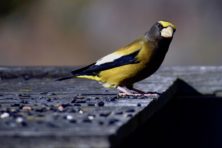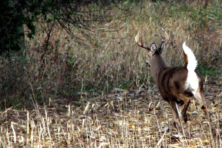Wild Things: Eligible Disabled Hunters May Apply for a Shot at Deer
- Share
- Tweet
- Pin
- Share
More than 70 landowners are opening thousands of acres of private land for a special October gun deer hunt for eligible hunters. Lands are open in 41 counties this year, including two properties in Kewaunee County and some larger parcels in Manitowoc and Outagamie counties. The rest are scattered across the state.
To be eligible, hunters or assistants must contact a hunt sponsor before Sept. 1. The hunter must provide her or his name, contact information and DNR customer ID number; and the hunter must possess a valid Class A, C or D disabled permit or Class B permit that is issued for longer than one year, authorizing shooting from a stationary vehicle.
Eligible hunters may sign up for one property per year and must possess a gun deer license.
There are some prime parcels of property in Door and Kewaunee counties that would be ideal to host a hunt for those with disabilities, including veterans. Interested landowners can find out more on the DNR website. Applications to sponsor a hunt are due June 1 each year.
Learn more at dnr.wisconsin.gov/topic/hunt/disdeer.html.
New Bear Zones in 2021
If you’d like a shot at hunting black bear in Wisconsin and have never done so, now’s the time to start planning.
Most hunters wait five to 10 years or more to draw a tag for the best areas in northern Wisconsin, but there are a few other options: participating in a Learn to Hunt Bear program, obtain a tag through the awarded permit transfer program, or cut the wait through a deceased customer preference approval transfer.
If none of those work, apply for the 2021 hunt by the Dec. 10 application deadline. There will be new management zone boundaries, so hunters should check carefully. It is not known how these changes will specifically affect harvest permit wait times.
More than 119,000 people applied for either a permit or a preference point for the 2020 hunt. There were 11,535 permits available, so most racked up a point to use toward future draws.
Wisconsin produces more black bears than any other state. Hunters here registered more than 3,000 animals in 15 of the last 20 years, including a string of harvests in the 4,000 to 5,000 range from 2009 to 2017.
The biggest complaint in a state with an estimated 25,000 bear is an eight- to 12-year wait for tags in the best northern Wisconsin range. On the other hand, if you choose to hunt outside of traditional bear country – where success rates are much lower – you can score a tag every year or two.
About one of every three hunters applying for a Zone C harvest tag got one with one preference point in 2018. It was five years minimum in Zone D (only one in five got a tag with five points), at least eight years in Zone A (nearly 89 percent got a tag with eight points) and a minimum 11-year wait in Zone B (46 percent got one with 11 points; others applied for at least 12 years before receiving a tag).
About half of the annual black bear harvest takes place during the first week of the season, early in September. After that, most are taken on weekend days, when hunter effort is highest.
Surveys show that about 75 percent of hunters use firearms when bear hunting. The remainder use bows or crossbows.
About 70 percent of the bears taken are over baited sites, and about two of every three are on private land. In comparison, four of every five bears taken with the aid of trailing hounds are shot on public land.
The 2020 hunt is set to begin Sept. 9, with bait hunters getting the earlier start. Hunting with trailing hounds is legal beginning Sept. 16 in northern zones.
Meanwhile, if you drew a 2020 Class A License tag and are considering transferring it to a youth hunter, observe the Aug. 25 deadline to do so.
Water-Levels Update
As of Aug. 14, Lake Michigan was four inches higher than last year and two inches above the previous record, set 34 years ago. There’s been little change during the past month, but the lake is projected to drop an inch by mid-September.





